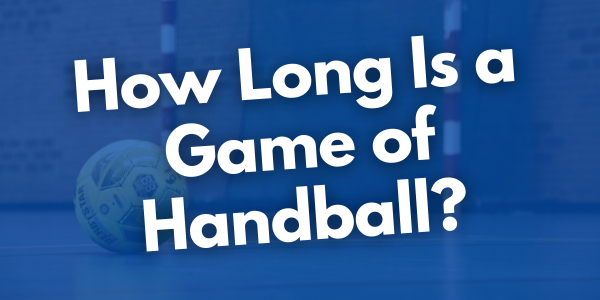Want to know how long an official game of handball takes to play?
A game of handball lasts 60 minutes. Two 30-minute halves are divided by a 10-minute intermission. A tie leads to a 10-minute overtime period which consists of two 5-minute halves with a 1-minute break. If the game remains tied, a second 10-minute overtime period is played, followed by a penalty shootout.
A game of handball can have up to 80 minutes of playing time. Although, it will take longer to finish due to the breaks and intermissions between the periods.
Halftime is always 10 minutes and the breaks in between overtime periods are always 1 minute. Players are given a 5-minute rest after 60 minutes before the overtime periods begin.
The duration of a handball game can be shorter if it involves younger players. Individuals under the age of 16 often play two 20-minute halves. In youth leagues, the length of a game is often decided by the administrators.

When Does the Game Clock Pause in Handball?
During a game of handball, a referee might choose the stop the game clock for a number of reasons. In most cases, a whistle is used by a referee to signal the stoppage of play and pausing of the game clock.
The time stops when:
- Either coach uses a time-out. A time-out is used by the coach to go over strategy or tactics, design a play, or give their players a rest. Each team can use only 1 time-out per half. Only the team with the ball can call a timeout.
- A player has been shown a card, has been suspended, or has been disqualified. The referee needs time to record the perpetrator’s name and number in their notebook.
- When the referee blows the whistle to pause the game for miscellaneous reasons. The referee can explain why the game is paused.
The game clock can be adjusted to make sure the game is stopped and started again at the appropriate time. A referee will blow his whistle to stop and start the game.
Does Time Stop in Handball When a Goal Is Scored?
As mentioned above, a referee can stop the game clock for a specific purpose, but for the most part, the clock continues to run throughout the entire game.
In handball, the game clock doesn’t stop for when a goal is scored. It keeps running during any event that can be considered a part of the game.
Time keeps going during these events:
- When a goal is scored
- During a substitution
- When the ball goes out of bounds
- During a free-throw
- During a penalty shot
This specific rule can be a little confusing to players familiar with basketball and hockey. Handball doesn’t have time stoppages for goals, substations, and free throws because they are all considered a part of the game.
How Long Is Overtime in Handball?
If a game of handball is tied after 60 minutes, it can be settled in an overtime period.
In handball, overtime lasts 10 minutes. Two 5-minute halves are played with a 1-minute break in between. If the score is still tied after 10 minutes, the 10-minute overtime is repeated. If no winner has been settled after the 20 minutes of overtime (score is tied), the game is settled in a penalty shootout.
It’s common for a game of handball to end in a tie, especially in recreational leagues. Professional league games also end in a tie. Penalty shootouts are often reserved for games where a winner must be decided, such as playoffs, tournaments, and the Olympic Games.
Who Keeps the Time in Handball?
Timekeepers in handball are impartial referees and judges. Usually, the game is refereed by 3 people, the main ref, and 2 sideline judges. The main referee is responsible for keeping the time, the score, and a record of warnings, suspensions, and disqualifications.
Although the sideline referees can assist in keeping track of the records, their main duty is to catch fouls, walks, and the ball going out of bounds. The side judge communicates what they notice to the main referee who makes the official judgment.
Want to Know More About Handball?
If you want to learn all the rules of the game, I’ve put together an article with everything you need to know. It’s called Handball Rules, How to Play Handball. The guide is equipped with a bullet point list of all the rules you need to know to play the game. Regardless of if you play indoors or at a beach, the same rules apply.
There, you’ll find a downloadable PDF of all the rules and regulations. Feel free to download my guide and share it with your teammate and organization.
Keep playing this amazing game, and always remember to be competitive and have fun.
